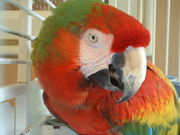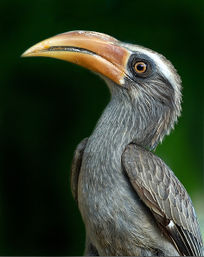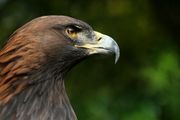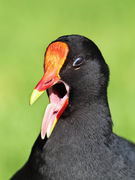Beak

Comparison of bird beaks, displaying different shapes adapted to different feeding methods. Not to scale.
The beak, bill or rostrum is an external anatomical structure of birds which is used for eating and for grooming, manipulating objects, killing prey, probing for food, courtship and feeding young. The term beak is also used to refer to a similar mouthpart in some Ornithischian dinosaurs, monotremes, cephalopods, cetaceans, pufferfishes, turtles, Anuran tadpoles and sirens.
Etymology
The terms 'beak' and 'bill' are interchangeable, although the former was formerly restricted to hooked beaks of birds of prey and parrots.[1]
Anatomy
Beaks vary significantly in size and shape from species to species. The beak is composed of an upper jaw, called the maxilla, and a lower jaw, called the mandible. The jaw is made of bone, typically hollow or porous to conserve weight for flying. The outside surface of the beak is covered by a thin horny sheath of keratin called the rhamphotheca. Between the hard outer layer and the bone is a vascular layer containing blood vessels and nerve endings. The rhamphotheca can include knob, which is found above the beak of some swans, such as the Mute Swan, and some domesticated Chinese geese (pictured).
The beak has two holes called nares (nostrils) which connect to the hollow inner beak and thence to the respiratory system.[2] The nares are usually at the base of the beak, near the dorsal surface. Kiwi are the only birds with nostrils at the end of their beak. [3] In some birds, the nares are in a fleshy, often waxy structure at the base of the beak called the cere (from Latin cera, meaning wax). The cere is an indicator of the reproductive cycle of budgerigars.[4]
Petrels and albatrosses have external horny sheaths called naricorns that protect the nares. These are separately placed on either side of the base of the upper mandible in albatrosses, but fused, with an internal septum, on the top of the base of the upper mandible in petrels.[5]. In the mallard, and perhaps in other ducks, there is no cere, and the nostrils are in the hard part of the beak, as a soft cere would be liable to injury when the duck dredges for food among submerged debris and stones.
On some birds, the tip of the beak is hard, dead tissue used for heavy-duty tasks such as cracking nuts or killing prey. On other birds, such as ducks, the tip of the bill is sensitive and contains nerves, for locating things by touch. The beak is worn down by use, so it grows continually throughout the bird's life.
Uses of beaks
As noted by Darwin in his observations on Galapagos Finches, birds' beaks have evolved to suit the ecological niche they fill: Raptors have decurved (downward curving) beaks for ripping up meat. Hummingbirds have long thin beaks for reaching nectar. The spoonbills' beaks allow them to filter-feed in shallow water. Unlike jaws with teeth, beaks are not used for chewing. Birds swallow their food whole, and it is broken up in the gizzard.
Billing
During courtship, mated pairs of a variety of bird species touch and clasp each other's bills. This is called billing and appears to strengthen the pair bond (Terres, 1980). Gannets raise their bills high and repeatedly clatter them (pictured); the male puffin nibbles at the female's beak; the male waxwing puts his bill in the female's mouth; and ravens hold each other's beaks in a prolonged "kiss".
Beak gallery
| A variety of beaks |
|
The bill of a male (Cob) Mute Swan, showing the knob. |
|
|
|
The bill of a scavenger—the Griffon Vulture.
|
|
|
|
The bill of a domesticated Chinese goose. The knob is highly exaggerated by farm selection.
|
|
|
|
Northern Gannets billing.
|
|
|
|
The bill of the Greater Flamingo.
|
|
|
|
The beak of a Brown Falcon.
|
|
|
|
The beak of an African Penguin.
|
|
|
The Kea uses its long curved beak to prey on animals as large as sheep. |
|
|
|
The beak of a Catalina Macaw
|
|
|
|
The beak of a malabar grey hornbill
|
|
|
|
Dusky Moorhen, Gallinula tenebrosa
|
|
See also
References
- Gilbertson, Lance; Zoology Lab Manual; McGraw Hill Companies, New York; ISBN 0-07-237716-X (fourth edition, 1999)
- Terres, John. K. The Audubon Society Encyclopedia of North American Birds, New York: Alfred A. Knopf, 1980. ISBN 0-394-46651-9
|
Birds (class: Aves) |
|
| Anatomy |
|
|
| Behaviour |
|
|
| Evolution |
|
|
Subclass: Neornithes
(29 orders of modern birds) |
|
Superorder: Palaeognathae
|
|
|
|
|
|
|
|
|
|
|
|
| Fossil birds |
|
|
| Birds and humans |
|
|
| Lists |
Families and orders • Genera • Lists by region • Extinct birds • Late Quaternary prehistoric birds • Sibley-Ahlquist taxonomy
|
|
| Category • Portal |
|

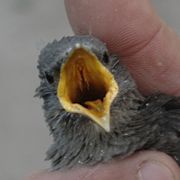
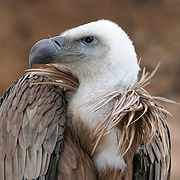
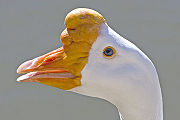
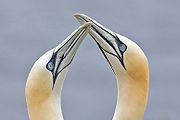
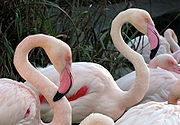
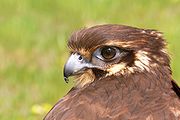
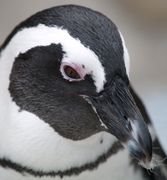
_-head_-Twycross_Zoo-8.jpg)
